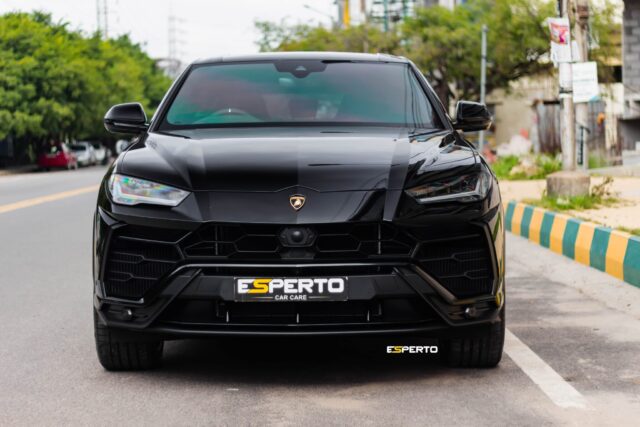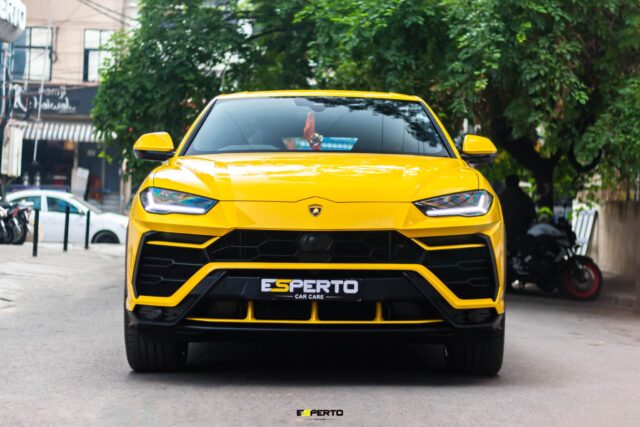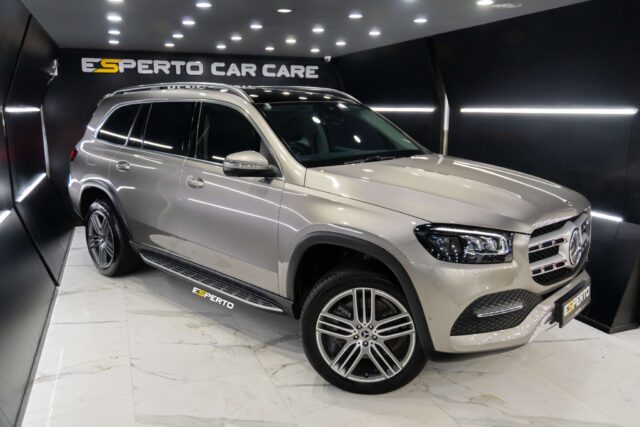Car Wax vs. Ceramic Coating: Which is the Best Paint Protection for Your Vehicle?
Choosing the proper protection for your car’s paint can be confusing. Many car owners wonder about the difference between car wax and professional ceramic coating service. This choice is important to keep your car’s finish looking great and protecting it from damage.
One fact you might find interesting is that ceramic coatings offer a higher level of protection compared to traditional waxes. Our article will guide you through both options, helping you decide which is best for your vehicle.
Let’s explore together.
What is the Difference Between Car Wax and Ceramic Coating?
Progressing from the basics, we proceed to understand the fundamental differences between car wax and ceramic coating. Both intend to maintain your car’s paint, but they do so in distinctly varying manners.
Car wax, mostly derived from natural waxes like carnauba, lays a protective layer on top of your vehicle’s paint. It imparts a glossy appearance to your car’s clear coat and guards it against dirt and UV rays.
However, this type of safeguard tends to lapse soon and typically requires periodic reapplication, generally every few months.
Contrarily, the ceramic coating provides a more robust solution for guarding your vehicle’s exterior. This modern technology applies nano-ceramic particles to establish a rigid layer over your car’s paint.
This coating not only offers supreme resistance to contaminants and scratches compared to standard wax, but it also sustains itself for a prolonged period—sometimes extending to several years with appropriate maintenance.
Although both products endeavor to keep your car at its finest, ceramic coating advances with its enduring durability and superior overall protection.
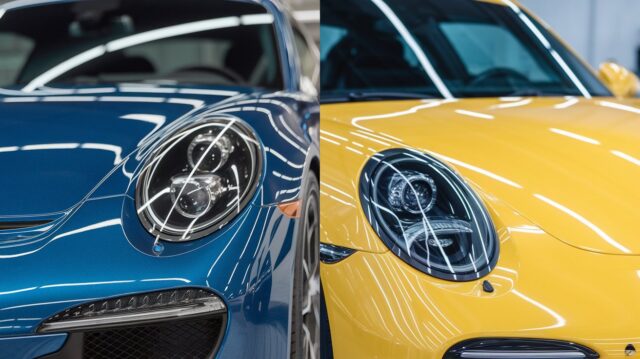
Understanding Ceramic Coating vs Wax
Choosing between ceramic coating and car wax for your vehicle involves understanding their unique attributes and how they protect your car’s paint. Let’s break down the key differences to help car owners, car enthusiasts, and bike rental car lovers make an informed decision.
| Aspect | Car Wax | Ceramic Coating |
|---|---|---|
| Base Composition | Natural waxes like carnauba | Synthetic polymers and ceramics |
| Protection Level | Provides a glossy finish and basic protection against dirt and water. | Offers advanced protection against chemical stains, UV rays, and etching. |
| Longevity | Lasts a few months before needing reapplication. | Can last several years with proper maintenance. |
| Application | Can be applied by hand or machine, easy DIY. | Professional application recommended for best results. |
| Cost | Less expensive, frequent applications required. | Higher initial cost, but more cost-effective in the long run. |
| UV Rays Protection | Offers moderate UV protection. | Superior UV protection to prevent paint fading. |
Understanding these differences helps you choose the right protection for your vehicle. Ceramic coating stands out for its durability and superior protection, while wax is more about aesthetics and requires regular applications. To make the best choice, consider your vehicle’s needs, your budget, and how long you plan to keep the coating or wax.
How Does Car Wax Work?
Continuing our look at the key differences between ceramic coating and wax, we turn our attention to how car wax functions. Car wax lays a protective cover over your car’s paintwork.
This guard enhances the shine of the car and also provides a barrier against various environmental risks such as dirt, UV rays, and light scratches. Carnauba wax, often hailing from palm leaves, is popular due to its natural hardening properties.
Applying carnauba wax to your vehicle results in a shield that repels water. This water-repellent trait ensures water forms into droplets that roll off with ease, reducing spots from mineral deposits in the water.
With the wax acting like a sunblock for your car, it prevents damaging UV rays that may cause color fading over time. This protective layer not only enhances the appeal of your car but also ensures long lasting shield and paint protection that holds up for several weeks to months before requiring another coat.
What Makes Ceramic Coating Different?
Ceramic coating provides enduring protection for vehicles, distinguishing it from common car wax. Contrasting with standard waxes made from carnauba that necessitate regular application, a ceramic coating layer unites with your car’s paint, forming a sturdy barrier.
This protective shield combats impurities more proficiently than wax, and its shine remains constant over time.
Professionals in car detailing often describe ceramic coating as an additional protective gear for your car’s paint.
This variety of coating repels water and due to being hydrophobic, it facilitates car cleaning by impeding dirt and grime from adhering to the paint’s surface further. Ceramic coatings have a hardness level that offers scratch resistance, outperforming synthetic car waxes or spray waxes.
With proper upkeep, a ceramic coat has the potential to last several years before a need for reapplication arises, unlike wax, which might demand care every few months.
How Do Car Wax and Ceramic Coating Protect Your Car?
Car wax, often made from carnauba wax, is a natural product that provides a layer of protection on the paint of your car. This protective layer helps to shield the car paint from UV rays and minor scratches, while also giving your vehicle a shiny finish.
The use of wax in car care routines dates back decades as an effective way to maintain the appearance and integrity of automotive paint.
On the other hand, ceramic coating offers long-lasting protection compared to traditional wax products. When applied, it forms a more durable bond with the vehicle’s paint surface that is extremely resistant, not just to UV rays but also to dirt, water, and chemicals.
This means cars treated with nano-ceramic coatings are easier to clean and retain their shine longer without repeated applications. The hydrophobic nature of ceramic allows for water beads to simply roll off the surface, reducing streaks and spots from water marks.
Now, let’s explore which among these offers better durability over time.
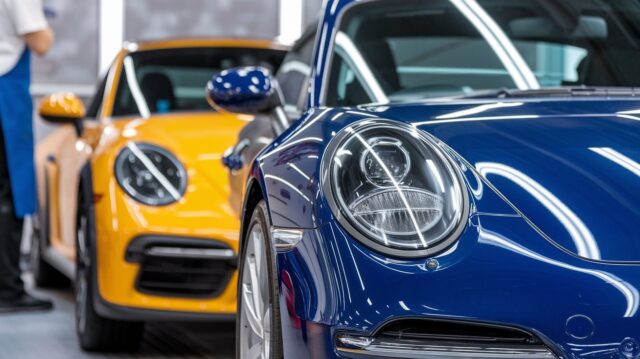
The Paint Protection Provided by Wax
Wax serves as a protective layer over your car’s paint, defending it from various elements such as dirt and pollutants. Produced largely from natural materials, which include carnauba wax, this kind of wax provides a brilliance that significantly improves your vehicle’s appearance.
The act of waxing your car augments its allure and also functions as a shield against minor scratches and UV rays. This approach to care is simple for any car owner to execute independently, marking it a favored option for preserving the gloss of the paint.
Consistent waxing aids in retaining cars’ fresh appearance by creating a smooth surface that repels water and contaminants. This habit elongates the lifespan of the paintwork by averting oxidation and fading due to exposure to sunlight.
For those who value their vehicles’ aesthetics or have an interest in maintaining resale value, integrating wax into normal upkeep schedules is advantageous. With offerings like paste or liquid form accessible in the market, choosing the suitable kind of wax provides you with a benefit in safeguarding your asset against wear and tear.
How Ceramic Coating Offers Extra Protection
Ceramic coating provides a strong protective layer over your car’s paint. This type of coating shields against various environmental contaminants like dirt, water, and UV rays. Unlike traditional wax, ceramic coatings bond with the paint on a molecular level.
This creates a durable barrier that lasts for years, not weeks.
Applying a ceramic coating to your vehicle ensures it stays cleaner longer. The smooth surface repels water and dirt effortlessly. This means less time spent washing and more protection from scratches or swirl marks caused by debris.
With nano ceramic coating’s ability to resist heat, the color of your car remains vibrant under the sun’s harsh rays compared to cars treated with wax alone.
Comparing UV Rays Protection
After exploring how ceramic coating offers superior protection for your vehicle’s exterior, it’s crucial to delve into how both wax and ceramic coating stand up against UV rays. UV radiation can cause significant damage to car paint, leading to fading and degradation over time. The right protective layer can significantly reduce these harmful effects.
| Protection Feature | Car Wax | Ceramic Coating |
|---|---|---|
| UV Rays Blockage | Provides moderate protection against UV rays, requiring frequent reapplication every few months for optimal results. | Offers high-level protection from UV rays due to its chemical properties, substantially reducing paint oxidation and fading for several years. |
| Reapplication Frequency | Needs reapplication 3-4 times a year depending on the product quality and environmental conditions. | Once applied, it can last for years, making it a more durable option against UV damage. |
| Effectiveness Over Time | Effectiveness diminishes rapidly, especially if the vehicle is frequently exposed to harsh sunlight. | Maintains consistent protection over the years, keeping the paint vibrant and less prone to fading. |
| Cost Efficiency | Initially less expensive but requires more frequent applications, adding to the long-term cost. | Higher upfront cost but more cost-efficient over time due to its durability and long-lasting protection. |
Protecting your vehicle from UV rays is crucial for maintaining its aesthetic appeal and structural integrity. While car wax offers a temporary solution, ceramic coating provides a more robust, long-term defence against the sun’s harmful effects.
Which is More Durable: Wax or Ceramic Coating?
The ceramic coating offers a level of durability far beyond what traditional carnauba wax can provide. The longevity of traditional wax spans just a few months, requiring frequent applications to maintain its protective and aesthetic benefits.
On the other hand, nano ceramic coatings promise years of paint protection film and against environmental contaminants, with some products lasting up to five years or more. This extended durability makes ceramic coating a preferred choice for car owners seeking long-term paint protection.
Ceramic coating is like giving your car armour that lasts for years, not just weeks.
Car enthusiasts appreciate the distinct advantages of the advanced technology behind ceramic coatings. These coatings create a stronger barrier against UV rays compared to wax, reducing the risk of oxidation and fading over time.
While applying a thin layer of wax might offer immediate shine and some degree of protection, choosing ceramic over traditional wax means investing in the future appearance and preservation of your vehicle’s exterior.
Longevity of Traditional Wax
Traditional wax, often made from carnauba, offers your car a glossy shine and some level of protection. Carnauba wax is derived from the leaves of Brazilian palm trees. This type of synthetic wax typically lasts for about four to six weeks under normal weather conditions.
Owners need to reapply it frequently to maintain the vehicle’s appearance and protective layer. Compared to ceramic coatings, traditional waxes wear off quicker due to exposure to sun, rain, and even through regular washing.
People choose this type of wax for its natural origin and the rich shine it provides. Applying carnauba wax can also be less costly upfront than opting for a ceramic coating service or DIY ceramic coating kits.
However, over time, the repeated applications required may add up in terms of the cost and effort needed to keep the paint protected effectively.

The durability of Nano Ceramic Coating
Shifting focus from conventional wax, it’s crucial to understand the durability and chemical resistance of nano ceramic coating. This advanced protective barrier surpasses its prior counterpart in terms of longevity and resistance.
Nano ceramic coating can last for several years, contrasting with carnauba wax that typically needs reapplication every few months. The secret to nano coatings its extended lifespan is the chemical bond it forms with the vehicle’s paint.
Once used, this type of ceramic coating forms a strong layer that guards against various contaminants, including dirt, road salt, and bird droppings.
Moreover, nano ceramic coatings provide superior protection against UV rays when compared to wax coatings. This suggests that it not only retains the luster of your car’s paint for extended periods but also guards it from fading due to sun exposure.
Car users preferring ceramic over conventional wax get the benefit of time savings and a longer duration of their vehicle’s aesthetic appeal. With features such as hydrophobic water-repelling properties included, putting money in a professional ceramic coating becomes a wise decision for those desiring strong protection for their cars or bikes.
How to Apply Wax and Ceramic Coating?
Applying a layer of ceramic coating or traditional car wax can protect your car’s paint and keep it looking new. The right choice between ceramic coating and traditional wax depends on your needs for durability, protection, and shine.
- Clean your car thoroughly before you apply wax or a ceramic coating. Remove all dirt, grime, and contaminants.
- If applying wax, choose a high-quality product formulated with carnauba wax for the best protection and shine. Carnauba wax is a natural product known for its durability.
- To apply wax, use a foam applicator pad. Apply the product in small sections using circular motions to ensure an even coat.
- Allow the wax to haze, which typically takes about 10 minutes. Then buff off the haze with a clean microfiber towel to reveal the shine.
- For ceramic coatings, start by ensuring the paint is as perfect as possible since the coating will lock in the current state of your paint job.
- Use an applicator pad to apply the ceramic coating solution to one panel at a time in straight lines for even coverage.
- Wait for the solution to bond with the paint; this may take up to 2 minutes, depending on conditions like humidity and temperature.
- Wipe off any residue with a clean microfiber towel immediately after it bonds to avoid streaks or high spots.
- Ceramic coatings usually require curing time, often 24-48 hours, without exposure to rain or heavy dew, for optimum hardness and protection levels.
- For DIY enthusiasts, applying carnauba-based waxes could be straightforward, while hybrid solutions such as ceramic spray coatings offer simpler application processes but might lack long-term durability compared to professional-grade nano-ceramic coatings.
- Professional application of ceramic coatings ensures optimum thickness and uniformity over your car’s surface but comes at a higher cost compared to DIY methods.
- Deciding whether to go DIY or professional depends largely on budget constraints and the desired level of protection for your vehicle’s paintwork.
Choosing between applying wax or opting for a more durable layer of ceramic coating involves evaluating factors such as how long you want the protection to last and how much you are willing to invest in maintaining your car’s appearance.
Steps to Waxing Your Car
Applying wax to your car enhances its gloss while providing a protective cover for the paint. This straightforward procedure helps maintain your car’s exterior in optimal condition. Here are the instructions to correctly wax your car:
- Identify the most suitable wax for your car. Frequent types of wax comprise carnauba and synthetic formulas, each granting varying degrees of gloss and protection.
- Clean your car thoroughly. Prior to initiating the waxing, certify that the car is devoid of any dirt, grime, or impurities that might cause scratches on the paint during the waxing process.
- Get your vehicle completely dry. Traces of water can impede the wax application, so ensure your car is thoroughly dry.
- Put a minimal quantity of wax on a foam applicator or microfiber cloth. A tiny amount suffices.
- Employ small sections, using round movements to administer the wax uniformly over your car’s surface.
- Leave the wax to dry out until it forms a haze. This might need approximately 5-10 minutes, based on the temperature and humidity.
- Polish off the dried wax with a fresh microfiber cloth, rotating it often to prevent accumulation.
- Repeat procedures 4 through 7 until you’ve treated all painted surfaces of your car.
This strategy will provide your vehicle with a defensive and protective coating that repels water and dirt, bestowing it with a great sheen that endures for weeks or months, depending on weather circumstances and the frequency of vehicle usage. Regular waxing is a decisive factor in sustaining that new car’s appearance and defending the car paint against environmental elements throughout the year.
Application of Ceramic Coating
Applying a ceramic coating to your car follows a comprehensive procedure that can offer exceptional protection. This protective layer defends the paint from various types of harm and gives your car a shimmering finish.
- Clean Your Car Completely: Initiate by cleansing your car to eradicate any dirt, dust, or grime. Utilize a premium car wash soap to confirm that the surface is clean.
- Dry the Vehicle Entirely: Following washing, dry your car thoroughly to avert any water spots. A microfiber towel fits perfectly for this stage.
- Clay Bar Treatment: Apply a clay bar over the surface of your paint to eradicate any pollutants that washing alone cannot abolish.
- Polish If Required: Inspect the paint for scratches or swirl marks. If visible, utilize a polish to even out the imperfections.
- Wipe Down with Isopropyl Alcohol (IPA): An IPA solution ought to be used to cleanse the vehicle post-polishing. This guarantees all oils and residues are eradicated.
- Apply Ceramic Coating: Put several drops of the ceramic solution onto an applicator pad and spread it consistently in overlapping strokes.
- Allow Time to Cure: Leave the coating to dry based on manufacturer guidelines, which can range from a day up to multiple days in specific conditions.
- Maintain Dry After Application: Avoid subjecting your vehicle to rain or washing it within two weeks post-application to allow optimum curing time.
Professionals in car detailing endorse adhering to these steps closely when you select ceramic coating for cars as it confirms maximum durability and efficacy of the protective layer on your vehicle’s paint.
DIY vs Professional Ceramic Coating
Transitioning from the detailed application of the ceramic coating, we compare the DIY versus professional ceramic coating options. This choice affects the quality of the work, the durability, and the effectiveness of the ceramic protection on your vehicle.
| Aspect | DIY Ceramic Coating | Professional Ceramic Coating |
|---|---|---|
| Cost | Less expensive upfront, costs vary based on quality of kit. | Higher initial cost, but includes labor and quality guarantee. |
| Application Process | Time-consuming, requires precision and patience. Mistakes can be costly. | Done by experienced technicians, ensuring a flawless finish. |
| Equipment | Basic tools included in kits, may not match professional-grade equipment. | Professionals use advanced tools and lighting for even application. |
| Quality and Longevity | Varies, depending on product quality and application skill. | Consistently high, with warranties often offered on workmanship. |
| Time Investment | Significant personal time required, often a full day or more. | Vehicle is typically ready within a day, with no effort from the owner. |
| Final Outcome | Potentially uneven coverage, risking protection gaps. | Uniform coverage ensuring maximum protection and shine. |
Choosing between DIY and professional ceramic coating depends on budget, time availability, and desired outcome quality. While DIY kits offer a cost-effective solution for enthusiasts willing to put in the effort, professional ceramic coating application ensures a superior finish with lasting durability, making it an excellent investment for those prioritizing perfection and protection for their vehicle.
When Should You Choose Ceramic Coating or Wax?
Choosing between ceramic coating and wax depends on what you value most for your car’s care. Ceramic coatings give your car a protective shield that lasts longer than traditional wax.
They fend off contaminants, water, and UV rays with ease, making them ideal for owners looking for long-term paint protection. On the other hand, car wax is more affordable and adds a nice shine to your vehicle quickly.
However, it doesn’t last as long and requires frequent reapplication to maintain its protective qualities.
Experts in car detailing often highlight the durability of nano-ceramic coatings as a game-changer for protecting the paint.
Cost comparison plays a big role too. Initially, applying a ceramic coating might seem pricier compared to waxing but considering its longevity; it could offer more bang for your buck over time.
For those who love keeping their vehicle in top-notch condition without regular visits to the detailer, ceramic might be right for your car. Yet, if you enjoy the ritual of waxing or have budget constraints, traditional wax remains a classic choice that keeps cars looking great.
Factors to Consider for Car Owners
Car owners must evaluate several factors before deciding on ceramic coating or traditional wax for their vehicles. The primary consideration should be the level of protection you want for your car’s paint.
Ceramic coatings provide a more durable barrier against environmental pollutants, UV rays, and scratches compared to common types of wax used in the market. This makes ceramic an excellent choice for those seeking long-term paint protection products.
Another crucial factor is maintenance and cost. Wax may need reapplication every few months to maintain its shine and protective qualities, while a nano-ceramic coating can last for years with minimal upkeep.
However, applying a ceramic coating initially costs more than regular waxing sessions but saves money over time due to its longevity. Owners should think about these aspects based on their budget, personal preference, how often they use their cars, and the conditions under which they are driven.
Next up: exploring the cost comparison between wax and ceramic coating helps further clarify this decision-making process.
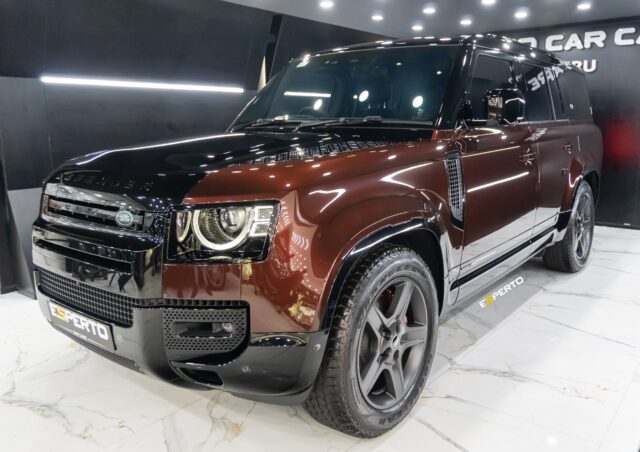
Cost Comparison of Wax and Ceramic Coating
Choosing between wax and a ceramic coating involves considering their costs. Car wax, especially carnauba wax, is more affordable. You might spend around $20 to $100 for quality wax on the market. Applying it yourself can save labor costs. Ceramic coatings offer longer protection but come at a higher price. Initial applications range from $500 to over $2,000, depending on the car size and the service’s quality.
Ceramic coatings last much longer than traditional waxes, justifying their higher upfront cost over time. Think of ceramic coating as an investment in your car’s future shine and protection.
Now, let’s look into how these choices impact your vehicle’s appearance over time.
Recommendations for Car Enthusiasts
Auto aficionados continually search for optimal methods to maintain their vehicles. If preserving the paint and retaining a long-lasting shine on your vehicle is your goal, considering the application of a ceramic coating may be a beneficial choice.
This defensive layer provides your car with an unparalleled gloss and also defends it against various pollutants more effectively than traditional wax. For those who favor the traditional method or are managing a tighter budget, car wax remains a trustworthy protective solution, enhancing the beauty of your vehicle with its inherent radiance.
Choosing between a ceramic coating and wax is contingent upon specific requirements, including your budget and the frequency of your vehicle’s use. A properly applied ceramic coating offers protection that outlasts carnauba wax, marking it as a superior investment for safeguarding your car’s paint over extended periods.
Prior to advancing with any decision, thoroughly contemplate all aspects to ensure your choice harmoniously aligns with what’s most suitable for the upkeep and presentation of your vehicle’s aesthetics.
Conclusion
Ceramic coatings and car wax both offer unique benefits to protect your car’s paint. Ceramic provides a stronger, longer-lasting barrier against the elements than wax. Waxing is easier and less costly for those on a budget.
Think about what matters most for your vehicle’s care. Exploring professional ceramic coating services can elevate your car’s protection and shine. Choose wisely to keep your car looking great year after year.



